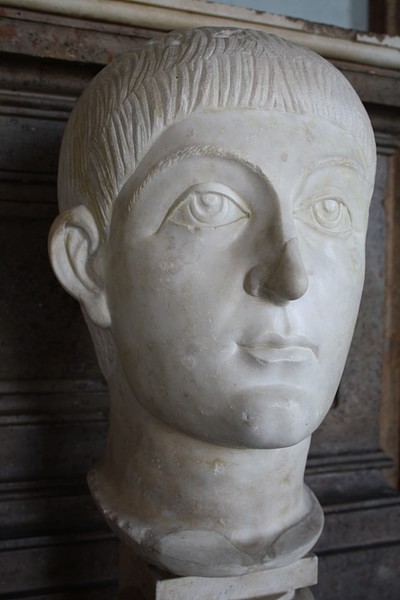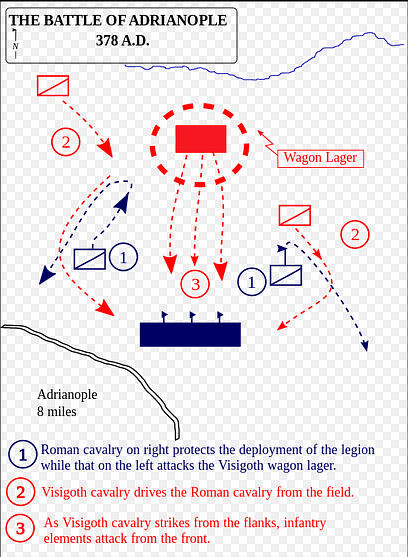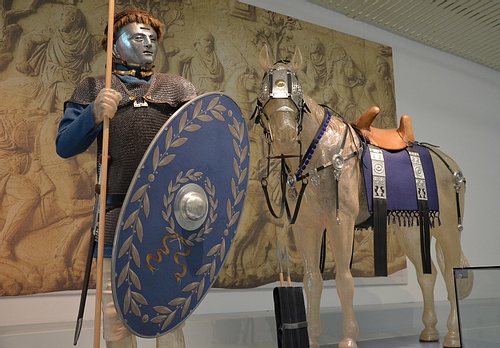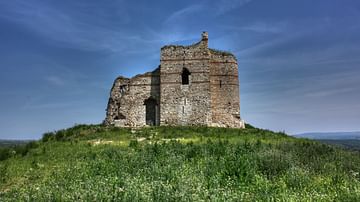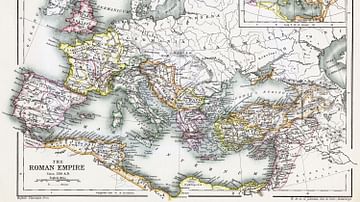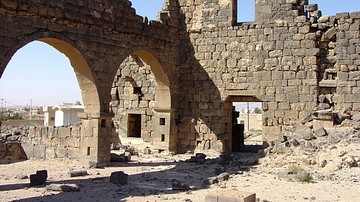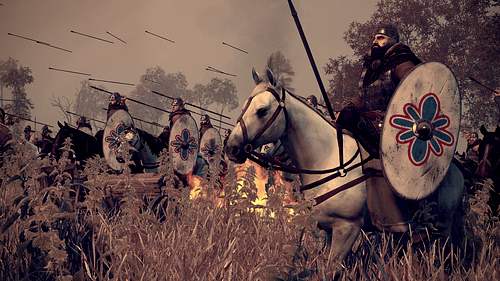
The Battle of Adrianople on August 9, 378 CE ranks among the worst military defeats in all of Roman history. Its estimated losses of over 10,000 are comparable to Roman defeats at Cannae (216 BCE) and Carrhae (53 BCE). The battle pitted the Germanic Ostrogoths and Visigoths under the leadership of the Thervingian chieftain Fritigern (d. c. 380 CE) against the unpopular and glory-seeking Roman emperor Valens (r. 364-378 CE). The disastrous defeat exposed Roman military weaknesses which eventually allowed for future barbaric attacks, creating a 'domino effect' that brought about the final decline and fall of the Roman Empire in the west. However, many historians agree that much of the blame for the tragic defeat was due to the poor leadership of Emperor Valens and not the ineptness of the Roman army. In his Roman History, 4th-century CE Roman historian Ammianus Marcellinus said “The annals record no such massacre of a battle except the one at Cannae, although the Romans more than once, deceived by trickery due to an adverse breeze of fortune, yielded for a time to ill success in their wars ....” (481).
Prelude
The hostilities between the Goths and the Empire began harmlessly enough. As the nomadic Huns moved westward across Asia wreaking havoc, the Visigoths, numbering over 200,000, moved from modern-day Ukraine to the frontier of the Roman Empire and, in 376 CE, crossed the Danube River and established themselves in Thrace. As the Huns continued their way westward into Europe the Gothic and Roman leadership made an alliance, and the tribes were finally given permission to permanently settle. It was an alliance unpopular with many Romans. However, the permission came with a caveat: in return for land and provisions, the Goths had to promise to provide soldiers for the Roman army. Other demands by unscrupulous Roman commanders (Lupicinus and Maximus) were soon made: children had to be provided to serve as slaves and all weapons had to be surrendered.
Facing starvation due to inadequate provisions and a lengthy famine, the Goths rose up against the Romans. After an attempt to assassinate the Gothic leaders Fritigern and Alavivus failed, Fritigern and his fellow Thervingi began pillaging the countryside. As the raiding continued, the Romans and Goths eventually met in battle at Marcianople (376 CE) and Ad Salices (Battle of the Willows, 377 CE). By 378 CE, the continuing disparity proved too embarrassing for Roman leadership, especially Emperor Valens who was engaged further east battling the Persians. As the Goths approached Constantinople, Valens heeded the frantic calls of its citizens, returned to the city, and marched against Fritigern.
Unfortunately for Rome, Emperor Valens' ego and desire for glory would spell disaster. The defeat at Adrianople would be the final chapter in a troubled reign. In 364 CE the Roman emperor Valentinian I (364-375 CE) had appointed his younger brother to be co-emperor and rule in the east with a capital at Constantinople. The ill-advised appointment brought a capable and successful, albeit unpopular, military leader onto the throne. Valens' unpopularity stemmed primarily from his support of the Arian Christians, angering both non-Christians and traditional Christians alike.
Battle Preparations
With the death of Valentinian in 375 CE, the 16-year-old Gratian, Valentinian's son, succeeded his father as co-emperor and commander in the west. Initially considered too young and inexperienced, Gratian would prove to be a skillful leader and along with skilled commanders have considerable success in Gaul. Unfortunately for the impatient and jealous Valens, he would be unable to lend support to his uncle against the Goths at Adrianople.
As Valens and his army waited anxiously in the hot weather outside Constantinople for his nephew to arrive, unreliable sources told him that the Gothic forces only numbered around 10,000, leaving him to believe he easily outnumbered them. He could not wait any longer. Like Marcus Licinius Crassus at Carrhae, Valens desired to garner all of the glory for himself. Urged into battle by his closest advisors “to make all haste in order that Gratian might not have a share in the victory which was already all but won,” he left camp and marched the eight miles to Adrianople to what would soon be his death (Ammianus Marcellinus, 465).
[Valens was anxious to do battle] … being eager to do some glorious deed to equal his young nephew, whose valiant exploits consumed him with envy. He had under his command a force made up of varying elements, but one neither contemptible, nor unwarlike; for he had joined with them also a large number of veterans. (Ammianus Marcellinus, 465)
Sources vary as to the actual size of both armies, but most agree that the Thervingi under Fritigern numbered initially around 10,000 and not the nearly 100,000 that some report. Valens was unaware that an additional 10,000 Greuthungi cavalry were away foraging and would arrive later. Most estimate Valens forces to number between 10 to 15,000. Ammianus wrote,
… the emperor was assured by his skirmishers that all that part of the enemy's horde which they had seen consisted of only ten thousand men and carried away by a kind of rash ardour, he determined to attack them at once. (465)
On the night before the battle, the Gothic commander sent a Christian priest to negotiate a possible peace, but Valens ignored any attempt at peace. Later, on the morning of August 9, Fritigern sent two more envoys to propose a truce. However, historians believe this latter attempt was only a stall tactic, waiting for the Greuthungi to arrive. Ammianus reaffirmed this belief when he wrote that as the Romans were establishing their line of defense, the barbarians became terrified at the sight and sound of the “whistling arrows” and sent envoys to beg for peace. However, he viewed it all to be a ploy “in order that during the pretended truce their cavalry (the Greuthungi) might return.” (469) The Goths also relied on another possible ally: the extreme August sun. The Romans were not only tired, hungry and thirsty from their long march but beaten down by the intense summer heat, “exhausted by their dry throats.”
The Battle
On the morning of the 9th, the Roman army, leaving provisions behind, marched from their camp to meet the Gothic forces who had already established themselves in a defensive position; a wagon circle containing the women, the elderly, children, and supplies.
So after hastening a long distance over rough ground, while the hot day was advancing towards noon, finally at the eighth hour they saw the wagons of the enemy, which, as the report of the scouts had declared, were arranged in the form of a perfect circle. (Ammianus Marcellinus, 465)
With part of his forces still away foraging, Fritigern's army (mostly infantry with a number of archers) assumed a strategic position along a nearby ridge; a position with the potential to charge the Romans when necessary. For years the Romans had depended largely on their infantry. Their cavalry had proven to be too unpredictable and had not as yet been fully integrated into the army, comprising only one-fourth of the Roman forces. The army established themselves into two lines with heavy infantry in the center, skirmishers (light infantry) in front of them, and cavalry on the left and right flanks. Ammianus wrote,
And while the barbarian soldiers, according to their custom, uttered savage and dismal howls, the Roman leader so drew up their line of battle that the cavalry on the right were first pushed forward, while the great part of the infantry waited in reserve. (469)
As usual, the Roman infantry which consisted of a number of seasoned veterans was equipped with the usual chain mail, round shields, and long swords. Although much of the Roman forces had not been fully deployed, two cavalry units, acting without orders, went on an unsuccessful attack but were quickly driven back. The battle had begun.
Even though the Roman forces were not fully prepared, the left wing was sent on the attack. Although making great progress - pushing the Goths back to the wagon circle - the Romans failed to recognize the arrival of the much-anticipated Greuthungi, accompanied by both Huns and Alans. According to Ammianus' account,
… the left wing, which had made its way as far as the very wagons, and would have gone farther if it had had any support, being deserted by the rest of the cavalry, was hard pressed by the enemy's numbers, it was crushed and overwhelmed, as if by the downfall of a mighty rampart. (475)
The Roman left wing had been attacked and completely shattered. The surviving members of the Roman left abandoned the battlefield, leaving the infantry fully exposed. The Therungi who were still positioned on the ridge were deployed, attacking the Roman infantry line. The overly-tired Romans were struck on both their front and flanks. Ammianus gave a descriptive account of what followed:
The foot-soldiers thus stood unprotected, and their companies were so crowded together that hardly anyone could pull out his sword or draw back his arm. Because of clouds of dust the heavens could no longer be seen, and echoed with frightful cries. Hence the arrows whirling death from every side always found their mark with fatal effect, since they could not be seen beforehand nor guarded against. (475)
The Romans were no longer capable of maneuvering and worst of all could not defend themselves being unable to even draw their swords. They were surrounded.
… the barbarians, pouring forth in huge hordes, trampled down horse and man, and in the press of ranks no room for retreat could be gained anywhere, and the increased crowding left no opportunity for escape, our soldiers also, showing extreme contempt of falling in the fight, received their death blows … (Ammianus Marcellinus, 475)
Just like at Carrhae, Gothic archers shot arrows into the Romans huddled together. The survivors soon broke ranks and fled only to be cut down by the Goths. Ammianus' description of the intense fighting and horror of battle can be seen in this description of the battlefield: “…when the whole scene was discoloured with the hue of dark blood, and wherever men turned their eyes heaps of slain met them they trod upon the bodies of the dead without mercy.” (477)
Emperor Valens and about 1,500 remained. Even the reserves had fled. The reports of Valens' death vary. In the end, his body was supposedly taken, wounded, to a nearby farmhouse only to have the Goths burn it down.
At the first coming of darkness the emperor, amid the common soldiers as was supposed fell mortally wounded by an arrow, and presently breathed his last breath; and he was never afterwards found anywhere. (Ammianus Marcellinus, 481)
In all two-thirds of the Roman forces, including Valens died. His body would never be found.
Thus then died Valens, at the age of almost fifty and after a reign of little less than fourteen years. Of his merits, as known to many, we shall now speak, and of his defects. He was a firm and faithful friend, severe in punishing ambitious designs, strict in maintaining discipline in the army and in civil life ... (and) just in his rule of the provinces. (484)
However, he was “desirous of great wealth, and impatient of toil, rather affecting awesome austerity than possessing it, and somewhat included to cruelty….” (487) And, Ammianus added, he was unjust and hot-tempered, a procrastinator, and irresolute.
Conclusion
Some blame for the Roman loss at Adrianople must be placed on the head of Emperor Valens. Like Crassus at Carrhae, Valens was seeking glory for himself and failed to wait for his nephew to arrive from the west. He had had success against the Goths earlier and with unreliable information telling him of the low Gothic numbers, he decided not to wait for Gratian and unfortunately marched to his own death, taking over 10,000 with him. With his nephew having success in Gaul, Valens wanted a successful defeat of the Gothic forces to be his and his alone.
Although not completely dismissing Valens failings, historians place the defeat on three key reasons:
- low morale - the Roman army was tired, hungry, and thirsty when they arrived at Adrianople
- poor and inadequate scouting - Valens had no knowledge of the 10,000 Greuthungi cavalry who would join Fritigern later
- the inadequately trained Roman cavalry - the Roman cavalry made a series of poorly planned and failed attacks against the Goths. These failed attacks led to an unprotected Roman left flank.
As Fritigern and his men attacked the Romans from the front and side, chaos ensued. The overwhelming numbers of the Gothic forces led to Roman soldiers deserting the battlefield. Valens was left alone with only a handful of men; his body was never found.
Unfortunately for Fritigern, he and his army would be unable to capitalize on his victory at Adrianople and have further success against the Romans. Having failed to capture Adrianople - the Goths did not have siege weaponry - the Gothic War (376-382 CE) continued to wreak havoc across the Roman frontier. Finally, in 382 CE Emperor Theodosius I and the Goths came to terms in an alliance that granted lands in exchange for soldiers to serve in the Roman army. The Adrianople defeat demonstrated weaknesses within the Roman military, and in the decades that followed, the empire in the west continued in a downward spiral until Alaric, a Visigoth leader and former Roman commander, invaded and sacked Rome in 410 CE. The west collapsed - the last emperor Romulus Augustulus relinquished the throne in 476 CE - but the empire in the east survived until being overtaken by the Ottoman Turks in 1453 CE.

